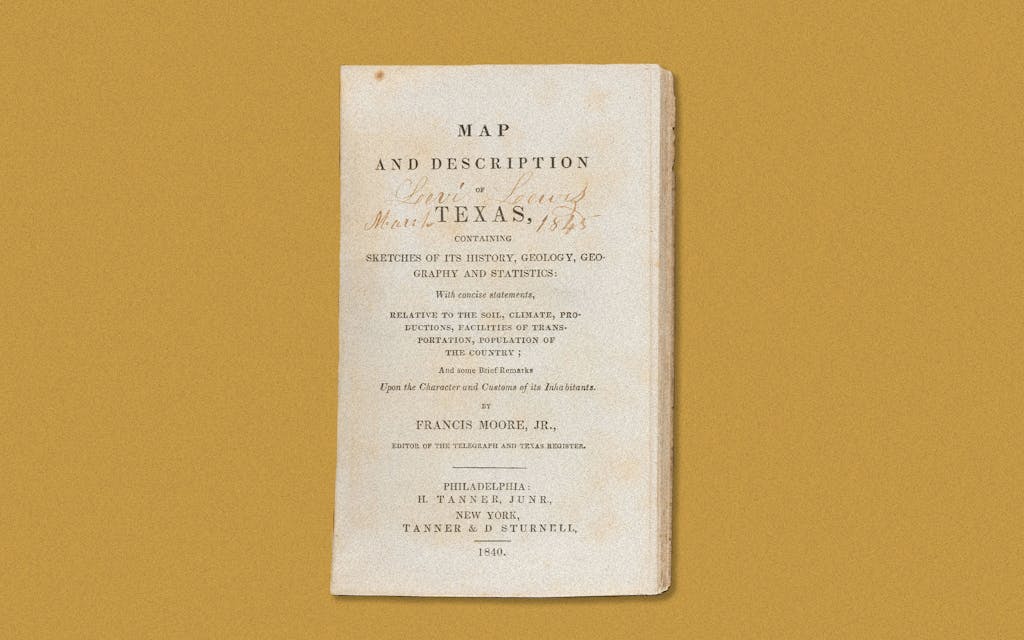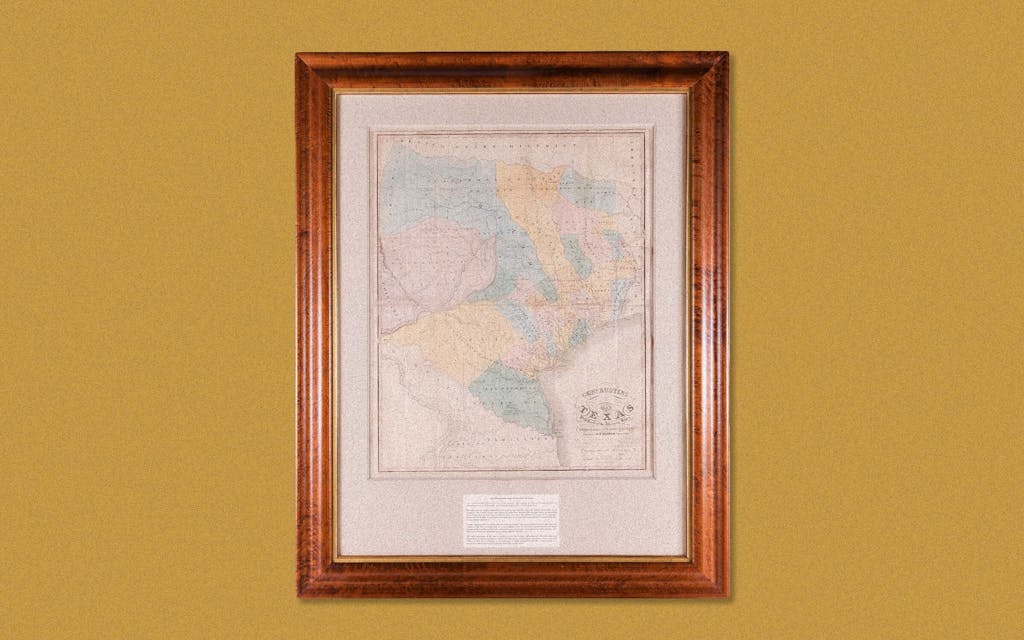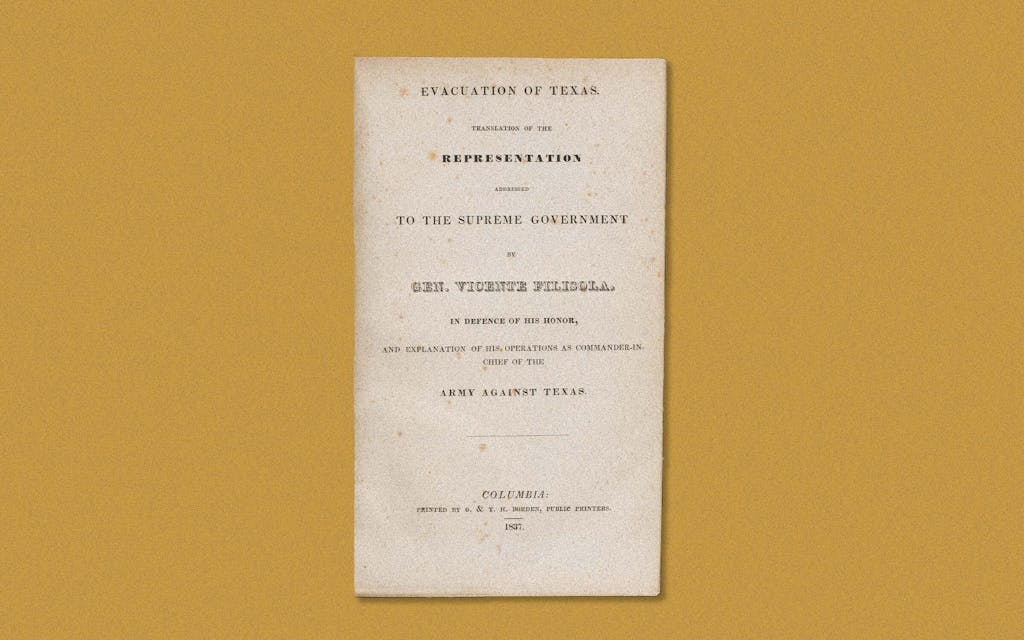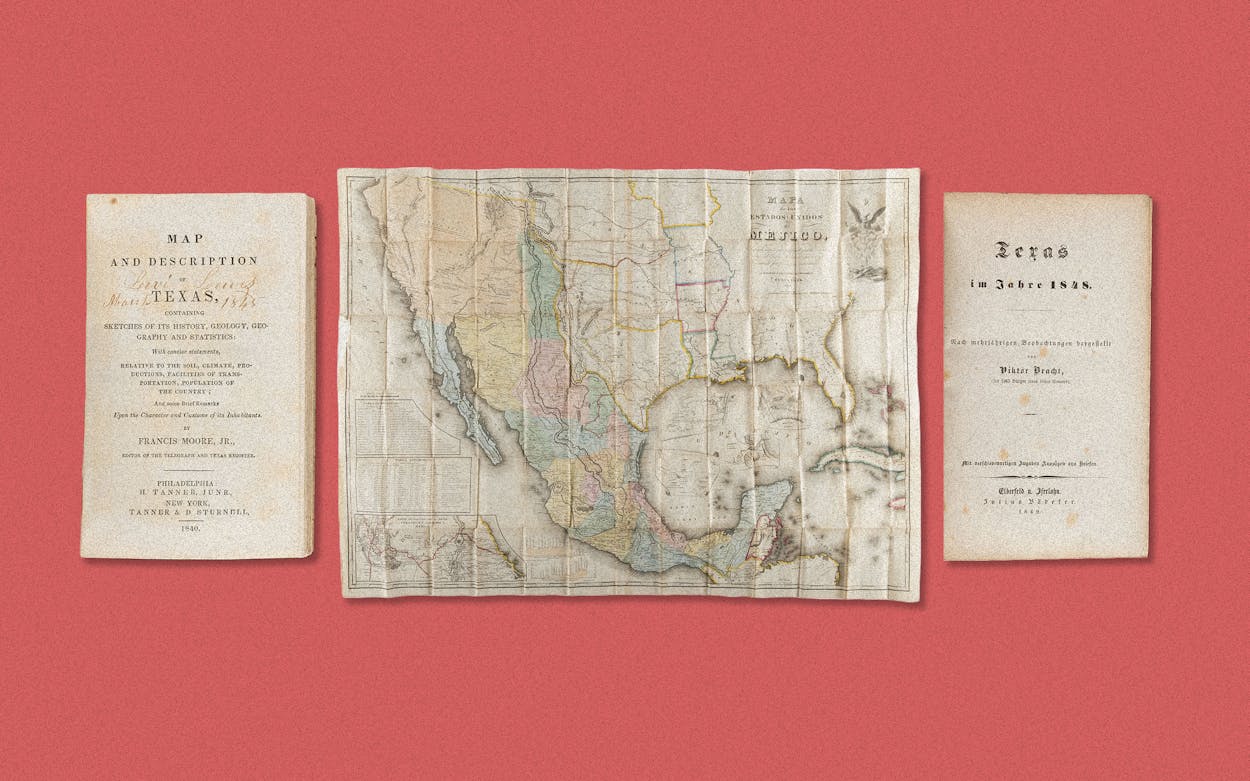Texans have a special relationship with their state’s history. If you grow up in Indiana, you don’t spend two years of your public school education on Hoosier history. Floridians don’t have a founding myth behind their state celebrated in cinema and song. North Dakota children don’t grow up hearing stories of the legendary figures who founded their (frankly) superfluous home state. But here, we remember the Alamo, quote Davy Crockett, and educate our children on the Battle of San Jacinto.
All of that history makes for a tantalizing market for artifacts. Search “Wisconsin history” on the website for Heritage Auctions—one of the world’s biggest memorabilia auctioneers, based in Dallas—and you’ll find only a couple hundred items for sale or previously sold, most of them related to the Green Bay Packers; the same search for Texas, meanwhile, yields more than 2,500 results. The great collections of those items don’t come up for sale very often—even the richest people on the planet couldn’t simply acquire some of the most unique pieces of Texas history, which only end up on the market when someone who already owns them decides to part with their collection.
That, however, is happening this Saturday, December 2, when the collection of Austin businessman Ted Lusher goes on the market in an auction from Heritage Auctions. Lusher began acquiring pieces associated with Texas history in 1982, after the Kansas City native moved to Waco. His first major purchase was an early edition of J. Frank Dobie’s The Longhorns. In the years since, Lusher’s obsession with the history of his adopted home state led him to a stint on the board of the Texas State Historical Association. He’s also loaned parts of his collection to the Bob Bullock Texas State History Museum. And yes, Lusher’s penchant for Texas memorabilia led him into several bidding wars with noted Alamo history enthusiast Phil Collins, whom Lusher describes as “a very formidable opponent” who was “very, very difficult, if not impossible, to outbid if he wanted something.”
Lusher acquired much of his collection with the assistance of Dorothy Sloan, a famed seller of antiquarian books who passed away in 2021 and in whose memory the auction is dedicated. With the items hitting the market on December 2, let’s take a look at some of the highlights.
Francis Moore Jr.’s 1840 Map and Description of Texas, Containing Sketches of Its History, Geology, Geography and Statistics

Describing this tome by Francis Moore Jr., the second mayor of Houston, as a rare first edition undersells the volume a bit. The book, written as a guide to the Republic of Texas for new immigrants, is one of just three known intact copies to feature the full map and plate illustrations in Moore’s original book. Those illustrations depict scenes of Texas locations that—at the time of the book’s publication—were more news than history, including accurate depictions of the ruins of the Alamo, the towns of San Antonio and Goliad, and Mission San José. The book also includes, in full color, a reproduction of the 1839 edition of Stephen F. Austin’s map of the state, the first such map to include the city of Austin, newly rechristened as the state’s capital. Austin—previously called Waterloo—had been established as the state capital that same year, and it is identified in this manner for the first time on the map.
Moore’s book is expected to fetch the highest price in the auction, with a starting bid of $200,000 (with Heritage’s 25 percent premium, that’ll be a cool quarter million). This copy belonged, in 1844, to one Levi Lewis and was found for Lusher by Sloan sometime around 2008. One of the two other copies of the volume, which belonged to the author Josiah Gregg, went to auction in 2007, fetching nearly $275,000.
The First Announcement of the Fall of the Alamo Published in English

How did Texians learn that the Alamo had fallen? Through a broadsheet printed and posted by Thomas Gay declaring that “I have just received information by Col. William T. Austin of the fall of the Alimo [sic].” (William T. Austin was an aide-de-camp to Stephen F. Austin, but not a relative, despite the name.) Gay was a minor figure in Texas history—Gay Hill, now a Washington County ghost town but once the home of Baylor University founder Robert Emmett Bledsoe Baylor, was named for him and his business partner, William Carroll Jackson Hill.
Gay’s broadsheet begins with the words “To the People of Texas” and cites both Austin and Juan Seguín as the sources of the information it conveys—and misspells the name of the famed mission as “Alimo” throughout. It was printed in a series of 150 copies, for which—according to the Texas State Library’s copy—Gay paid the princely sum of $10 (around $330 in today’s dollars). This is another item expected to sell for a high price, with a starting bid of $75,000, plus the Heritage premium. Alamo pieces, according to Lusher, have a larger collectors’ market than more general Texas history items, and as far as he’s aware, this is the only copy of the broadsheet that still exists. Does that mean Phil Collins is going to buy it? “I don’t know!” Lusher says. “He might.”
Stephen F. Austin’s Genl. Austins Map of Texas With Parts of the Adjoining States

Stephen F. Austin’s map of Texas was originally created in 1830, and it was subsequently updated over the course of the next sixteen years. (This is, incidentally, the same map reproduced in Moore’s book.) The final geographic update to the map was published in 1846, making it the only edition released after Texas entered the United States. Austin’s map was broadly accurate, which was a rarity at the time, making it a scientific breakthrough in the middle part of the nineteenth century. It was published as a pocket map, popular among immigrants, who used it to navigate their new home; as a result, those maps were frequently folded and refolded to the point of disintegration, rendering intact copies scarce. Lusher can identify only a handful of other collectors, as well as some institutions such as the Texas General Land Office and a marquee public university or two, that possess copies. Beyond that, he says, it’s possible that there may be a copy or two that have been passed down over the generations in private hands, but those are likely the only copies still in existence. Accordingly, previous editions of the map have sold for as much as $200,000. (A reproduction, meanwhile, will set you back $90.) The bidding on this copy of the map will open at $65,000, though we’ll expect the final sum to be significantly higher.
A First English Edition of Vicente Filisola’s Evacuation of Texas

During the Texas Revolution, General Vicente Filísola, an Italian-born, Spanish-raised immigrant to Mexico, served as Santa Anna’s second-in-command. Given how that turned out, Texans were interested in his account of what happened—which he wrote four months after the Battle of San Jacinto, as an apologia for his own actions during the war. It was one of the first books printed in—and by—the Republic of Texas, and it was translated into English by a vote of the Texas Congress at the request of Stephen F. Austin, who obtained a copy in November of 1836, while Austin was secretary of state. Lusher says that while he can’t authoritatively state that it was the very first book published in Texas, the historian John Jenkins claimed that it did indeed hold that distinction; at the very least, there’s no evidence of an earlier book published in the state.
Two copies of the Spanish-language edition, published in Mexico, have gone to auction at Heritage, both selling for less than $2,000—though in worse condition, and more than a decade ago. Bidding on this copy opens at $17,500, meaning that the two editions aren’t directly comparable in their significance.
- More About:
- Texas History
- Books
- San Antonio
- Austin








